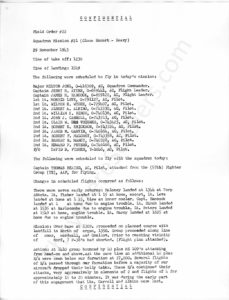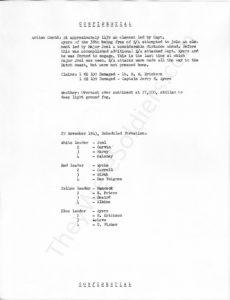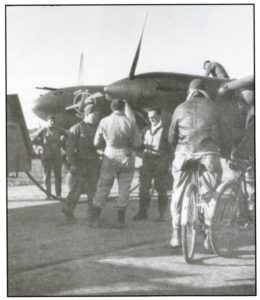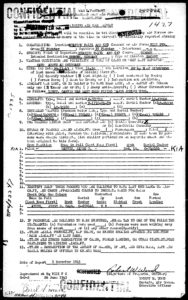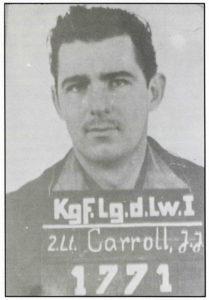[This post, created on November 20, 2020, has been updated. The post now includes: 1) An area map and formation diagrams that provide a more accurate and clearer representation of the nature of the 55th Fighter Group’s encounter with the Luftwaffe on November 29, 1943, and 2) An additional photograph of Lieutenant John S. Hascall. Where necessary, other parts of the account have been corrected. Scroll on down for a look…!]
A Monday in November: Major Joel’s Last Mission
On the 29th of November, 1943, the VIII Fighter Command was tasked with escorting heavy bombers to Bremen, Germany.
As described by Roger Freeman in The Mighty Eighth, “…the 55th Group again set forth to Bremen, with elements of the 20th Group bringing up the rear. Just after crossing the Dutch coast at 31,000 ft, Me109s of III J.G.1 pounced on the Lightnings in a surprise attack evidently designed to entice the Americans into releasing their drop tanks prematurely. Another seven P-38s failed to return to base although three of the enemy were definitely shot down.”
By day’s end, the 8th Air Force lost 16 fighters (7 P-38Hs and 9 P-47Ds), and 13 B-17s (7 Fs and 8 Gs).
Losses of aircraft by Groups were:
Bombers
94th Bomb Group: 1
95th Bomb Group: 1
96th Bomb Group: 4
303rd Bomb Group: 2
379th Bomb Group: 2
385th Bomb Group: 2
388th Bomb Group: 1
Of the 130 men aboard these 13 aircraft, there would be 54 survivors.
Fighters
20th Fighter Group: 1
55th Fighter Group: 6
56th Fighter Group: 1
355th Fighter Group: 3
356th Fighter Group: 5
Of the 7 P-38 losses, two men – both members of the 55th Fighter Group – survived. They were:
2 Lt. John J. Carroll
and
2 Lt. Fleming W. Suiter
Of the 9 P-47D losses, 5 men survived…
2 Lt. Charles K. Hecht, Jr., 355th Fighter Group, 358th Fighter Squadron, Aircraft 42-8631, YF * U (MACR 1284)
2 Lt. Richard Peery, 355th Fighter Group, 358th Fighter Squadron, Aircraft 42-22484, YF * L (MACR 1285)
1 Lt. Warren H. Beach, 356th Fighter Group, 359th Fighter Squadron, Aircraft 42-8601 (MACR 1451)
2 Lt. John D. Hull, 356th Fighter Group, 359th Fighter Squadron, Aircraft 42-8598 (MACR 1452)
and
2 Lt. Julius B. Ashbridge, 356th Fighter Group, 360th Fighter Squadron, Aircraft 42-8502, PI * W, “Hell’s Angel” (MACR 1436)
…and 4 were killed in action:
2 Lt. Alfred J. Del Negro, 355th Fighter Group, 354th Fighter Squadron, Aircraft 42-7996, WR * D (MACR 1286)
2 Lt. Johnnie F. Martin, 356th Fighter Group, 361st Fighter Squadron, Aircraft 42-8692, QI * Q (MACR 1543)
1 Lt. Allan M. Metzger, 356th Fighter Group, 361st Fighter Squadron, Aircraft 42-8509, QI * O (MACR 1453)
2 Lt. Frederick C. Windmayer, 56th Fighter Group, 63rd Fighter Squadron, Aircraft 42-7893, UN * F (MACR 1278)
Balanced against these fighter losses were VII Fighter Command claims of 13.5 German aircraft destroyed, with P-47s achieving 11.5 victories, and P-38s 2.
Aerial victories were confirmed as follows:
P-38s
55th Fighter Group
38th Fighter Squadron: 1 Victory
338th Fighter Squadron: 1 Victory
P-47s
56th Fighter Group
61st Fighter Squadron: 3 Victories
62nd Fighter Squadron: 1.5 Victories
63rd Fighter Squadron: 1 Victory
355th Fighter Group
358th Fighter Squadron: 1 Victory
356th Fighter Group
359th Fighter Squadron: 3 Victories
360th Fighter Squadron: 1 Victory
361st Fighter Squadron: 1 Victory
And so…
…akin to the prior post – covering Major Joel’s previous combat missions – this post includes:
1) 38th Fighter Squadron Pilot’s Personal Encounter Reports for pilots who engaged in combat with German fighters on this mission
2) Mission Reports filed by the 38th and 388th Fighter Squadrons (…is there one for the 343rd? – I don’t know…)
3) Names of all 55th Fighter Group pilots assigned to the mission (derived from the 38th’s and 338th’s Mission Reports, and for the 343rd, the Squadron History Summary. This is supplemented by information from the 55th Fighter Group website
4) Missing Air Crew Reports covering the 20th and 55th Fighter Group pilots lost that day. This includes the “first” page for every such MACR, and an Oogle map showing the area where their aircraft are known (or assumed) to have crashed, based on a variety of references.
________________________________________
Given the great length (gadzooks…) and complexity (double gadzooks…) of this series of posts, perhaps it’s best to start with an illustration visually summarizing Eighth Fighter Command P-38 losses on the mission, in the form of a diagram superimposed on an Oogle map – below – of northwestern Europe. This map will appear in subsequent posts.
[Updates to this map from its initial version include the following: 1) The crash locations of three Me-109G-6s of the Seventh Staffel of Jagdgeschwader 1, lost (directly or indirectly) as a result of III./JG 1’s engagement with the 55th Fighter Group’s Lightnings, 2) An adjustment to the easternmost “leg” of the 55th Fighter Group’s intended course into Germany (ironically, the 55th never actually reached Germany!), 3) The crash locations, as much as they can be pinpointed on an ultra-small-scale digital map, of 38th Fighter Squadron pilots Lieutenants Carroll and Gilbride, 4) The serial numbers of the lost P-38s and the three above-mentioned Me-109G-6s. Information about the three 7./JG 1 losses, and the crash locations of Lieutenants Carroll and Gilbride comes from Part 2 of Teunis Schuurman’s WW II – Research by PATS blog.]
 Maps symbols and colors indicate the following:
Maps symbols and colors indicate the following:
Bright blue line extending west to east across the Netherlands to a point near the Dutch-German border indicates the approximate or intended course of the 55th Fighter Group for a rendezvous with 8th Air Force bombers.
Black triangle shows the approximate area where the Luftwaffe initially assumed it would intercept the 55th Fighter Group’s P-38s, as explained in the book Jagdgeschwader 1 und 11: Einsatz in der Reichsverteidigung von 1939 bis 1945 (Jagdgeschwader 1 and 11: Used in the Defense of the Reich from 1939 to 1945).
Blue ovals with names adjacent indicate the last reported or assumed location of P-38 losses, based on information in Missing Air Crew Reports.
Red ovals with names adjacent indicate the actual locations where the P-38s were lost. Notice that there’s no blue oval for Lt. Hascall, because his P-38 was last sighted over the North Sea, at a point “west” of (to the left of) this map view, and Lieutenant Garvin, Major Joel’s wingman, because he definitely crashed at Hondschoote, France (again, well “off the map”). More information will be presented about Lt. Garvin’s fate in subsequent posts.
The location of Major Joel’s loss remains unknown. Some sources suggest the crash location was Marken Island in the Markermeer, indicated by a yellow oval.
In subsequent posts, I’ll discuss why I believe this location is incorrect.
Black ovals with names adjacent indicate the loss locations of three Me-109G-6s of 7/JG 1.
[And… Here’s the “original” map”….]
 We begin with the 38th Fighter Squadron’s Mission Report.
We begin with the 38th Fighter Squadron’s Mission Report.
November 29, 1943
Mission Report – 38th Fighter Squadron
Changes in scheduled flights occurred as follows:
There were seven early returns: Maloney landed at 1344 at Torp [sic] Abbots. Lt. Fisher landed at 1_15 [not legible in microfilm] at home, escort, Lt. Leve landed at home at 1 _15 [not legible in microfilm], blew an inner cooler. Capt. Hancock landed at 1___ [not legible in microfilm] at home due to engine trouble. Lt. Birch landed at 1535 at Earlscombe due to engine trouble. Lt. Peters landed at 1549 at home, engine trouble. Lt. Marcy landed at 1625 at home due to engine trouble.
Mission: Over base at 1309. Proceeded on planned course with landfall in North of _____ergen [not legible in microfilm], 1350. Group proceeded along line of Lemmer, Noordwolde, and Grolloo. Prior to reaching vicinity of Aschendorf, 7 P-38’s had aborted. Flight plan attached).
Action: At 1410 group bounced by 40 plus ME 109’s attacking from head-on and above. At the same time an additional 40 plus E/A were seen below our formation at 27,000. Several flights of E/A passed through our formation before a majority of our aircraft dropped their belly tanks. These E/A continued their attacks, very aggressively in elements of 2 and flights of 4 for approximately 15 to 20 minutes. It was during the early part of this engagement that Lts. Carroll and Albino were lost.
Action Contd: At approximately 1439 an element led by Capt. Ayers of the 38th being free of E/A attempted to join an element led by Major Joel a considerable distance ahead. Before this was accomplished additional E/A attacked Capt. Ayers and he was forced to engage. This is the last time at which Major Joel was seen. E/A attacks were made all the way to the Dutch coast, but were not pressed home.
Squadron Formation – 38th Fighter Squadron
The “first” version of this post presented diagrams of what I assumed (?!) was the 38th Fighter Squadron’s formation during the November 29 mission. These were based on a document from the history of the 38th’s brother squadron – the 338th – showing a plan view of the organization of the 338th, by Flights, during the Bremen mission. But, on reflection and intuition, I began to wonder about this: Could the “layout” of the 338th’s formation in its squadron history have simply reflected nothing more than (* ahem *) the size and format of the original 8 1/2″ x 10″ document itself, rather than the actual formation used in combat?
So, I took another “look”. I discovered “8th Air Force Tactical Development, August, 1942 – May, 1945”, at Archive.org. And within, I discovered the diagram below, which presents the structure of 8th Air Force Fighter Group formations during late 1943 through early 1944:]
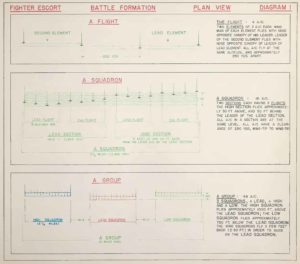 So… Using the upper and central diagrams as references, here are two (brand new) diagrams showing: 1) the formation of the 38th Fighter Squadron at the start of the November 29 mission, and, 2) immediately before the squadron was intercepted by III/JG 1. The diagrams are purely diagrammatic, and as such are intended to represent the composition of each of the squadron’s four flights and the location of its planes relative to one another, rather than (obviously!) the scale of the actual distances between each plane; between each of its fours flight; between its two sections.
So… Using the upper and central diagrams as references, here are two (brand new) diagrams showing: 1) the formation of the 38th Fighter Squadron at the start of the November 29 mission, and, 2) immediately before the squadron was intercepted by III/JG 1. The diagrams are purely diagrammatic, and as such are intended to represent the composition of each of the squadron’s four flights and the location of its planes relative to one another, rather than (obviously!) the scale of the actual distances between each plane; between each of its fours flight; between its two sections.
And (of course!) the direction of flight (this day, east-northeast) is towards the top of your screen or tablet.
In both diagrams, the name of each pilot is correlated to his position within the formation.
This “first” diagram shows the formation as planned; as it would – in theory – have been arranged before its interception by III./JG 1. Those seven planes that returned to Nuthampstead early are indicated by relevant text (i.e. “Engine Trouble”), while the four pilots lost that day – Major Joel, and Lieutenants Albino, Carroll, and Garvin – are denoted in red, with the serials of their P-38s adjacent.
 This “second” diagram shows … well … what was left of the 38th by the time it came under attack by enemy planes: There are nine aircraft remaining. Note that: 1) The outermost flights of both the Lead and High Sections are gone, 2) The innermost flights of the High Section remain intact, 3) The relative locations of the remaining two Elements from both Flights in the Lead Section suggest a spur-of-the-moment creation of two “improvised” Flights. Which, as we will see, is what Major Joel was attempting to do at the moment his squadron came under attack.
This “second” diagram shows … well … what was left of the 38th by the time it came under attack by enemy planes: There are nine aircraft remaining. Note that: 1) The outermost flights of both the Lead and High Sections are gone, 2) The innermost flights of the High Section remain intact, 3) The relative locations of the remaining two Elements from both Flights in the Lead Section suggest a spur-of-the-moment creation of two “improvised” Flights. Which, as we will see, is what Major Joel was attempting to do at the moment his squadron came under attack.
 Unfortunately, the names of the Dutch towns or cities which served as landmarks for the route of the 38th (and its brother squadrons?) towards Bremen are not fully legible in the microfilm copy of the 38th’s Mission Report, but I believe these locations were – as one moves from west to east – Lemmer, Noordwolde, and Grolloo. Doubly unfortunately, the 38th’s Flight Plan for the mission is absent from the microfilmed squadron history.
Unfortunately, the names of the Dutch towns or cities which served as landmarks for the route of the 38th (and its brother squadrons?) towards Bremen are not fully legible in the microfilm copy of the 38th’s Mission Report, but I believe these locations were – as one moves from west to east – Lemmer, Noordwolde, and Grolloo. Doubly unfortunately, the 38th’s Flight Plan for the mission is absent from the microfilmed squadron history.
By comparing the 38th Fighter Squadron’s Mission Report with that of the 338th (below), it seems (?) that the 38th – having departed Nuthampstead at 1230 hours, was the 55th Fighter Group’s lead squadron, for the 338th departed later at 1259 hours, with that squadron’s mission report specifically stating that it was the “center” squadron of the 55th formation. As for the 343rd? I don’t know, but it was thus probably the rear-most squadron.
The most striking aspects of the mission are:
1) The squadron was depleted to a little over half its strength – from sixteen to nine aircraft – by the time it was intercepted by Me-109s. The 338th experienced a parallel decrease in its fighting power.
2) The sheer number of enemy fighters – certainly over forty – attacking head-on, from a higher altitude: a ratio of over four to one;
3) The intensity and duration of the squadron’s combat with German fighters, interception having commenced at 1410, with Major Joel presumably being shot down at @ 1440. Thus, the Squadron was engaged in combat for at least a half-hour by the time Major Joel was shot down – and this was before the loss of the Group’s other P-38s;
4) There is no evidence – at least, nothing recorded – that the 38th was actually able to rendezvous with the B-17s that the 55th Fighter Group had been assigned to escort;
5) (This will come in later…) There was an overcast at 27,000 feet, corroborated in Missing Air Crew Reports for the Group’s losses.
Pilot’s Personal Encounter Report – Captain Jerry H. Ayers
 Transcript of Pilot’s Personal Encounter Report – Captain Jerry H. Ayers
Transcript of Pilot’s Personal Encounter Report – Captain Jerry H. Ayers
Two ME 109’s were attacking two P-38’s from three o’clock in front of me. My wingman and I started to close in and knock them off but they did not press home their attack. Instead they flew straight through behind those airplanes and in front of us.
I turned left with them and picked a four radii lead on the lead ME 109. I held this lead and fired from 90 degrees deflection to 45 degrees. The range was about 250 yards.
I was forced to break off my attack and was unable to observe any results because of four ME 109’s coming down on us from behind. We continued our turn to the left and we turned into this attack which was broken off before we were in firing range.
Lt. Erickson, my wingman later stated that he saw the airplane going down in a slight spin in flames and trailing thick black smoke, so I concluded that this aircraft was destroyed by my attack.
The ME 109’s were painted with a mottled brown camouflage and had what appeared to be a large red ball painted at the rear of the fuselage where the Luftwaffe cross usually appears.
Pilot’s Personal Encounter Report – Captain Thomas E. Beaird, Jr.
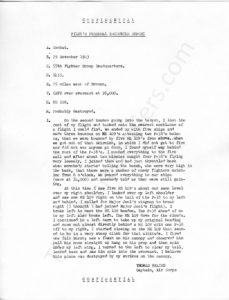 Transcript of Pilot’s Personal Encounter Report – Captain Thomas E. Beaird, Jr.
Transcript of Pilot’s Personal Encounter Report – Captain Thomas E. Beaird, Jr.
On the second bounce going into the target, I lost the rest of my flight and tacked onto the nearest semblance of a flight I could find. We ended up with five ships and made three bounces on ME 109’s attacking two P-38’s below us, then we were bounced by five ME 109’s from above. When we got out of that skirmish, in which I did not get to fire nor did not see anyone go down, I found myself way behind the rest of the P-38’s. I pushed everything to the fire wall and after about ten minutes caught four P-38’s flying very loosely. I joined them and had just throttled back when somebody started telling the bunch, who were very high in the back, that there were a number of enemy fighters catching from 6 o’clock. We poured everything to our ships (were at 34,000) and somebody told us they were still gaining.
At this time I saw five ME 109’s about our same level over my right shoulder. I looked over my left shoulder and saw one ME 109 right on the tail of the P-38 to my left and behind. I called for Major Joel’s wingman [Lt. Garvin] to break (I thought I had joined Major Joel’s flight). I broke left to meet the ME 109 head on. The P-38 ahead of me to my left also broke left. The ME 109 dove for the clouds. I continued in a left turn to take up my original heading and came out almost directly behind a ME 109 with one P-38 off to my right. I started closing on the ME 109 that seemed to be in a very steep climb for that altitude. I fired one fair burst; saw a flash on his canopy and observed him pull his nose straight up hang on his prop and then spin under my left wing. I turned to the left to clear my tail, looked back and saw him spin into the overcast. I believe this plane was destroyed by my strikes on the canopy.
Pilot’s Personal Encounter Report – 2 Lt. Robert E. Erickson (1)
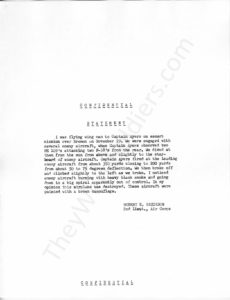 Transcript of Pilot’s Personal Encounter Report – 2 Lt. Robert E. Erickson (1)
Transcript of Pilot’s Personal Encounter Report – 2 Lt. Robert E. Erickson (1)
I was flying wing man to Captain Ayers, who was leading Swindle Red Flight. After engaging with enemy aircraft and completing three 360 degree orbits, we started for home. Captain Ayers and myself were two of five P-38’s at the rear of the group. We observed three enemy aircraft catching us from the rear. At this time I was at 33,000 feet. Captain Ayers called for help and Captain Franklin and Lt. Gilbride of the 343rd came back. At this time one enemy aircraft came behind Captain Franklin and two behind me. We broke left, I completed my turn and came down on the second ME 109 and fired observing hits on wings and near canopy. These two immediately rolled and dove for the clouds. Captain Franklin had to feather his engine in the middle of his break and Lt. Gilbride presumably was shot down. I then broke off my attack as the ME 109’s dove and flew back to cover Captain Franklin who was then on one engine. At this time four more enemy aircraft were tailing me so Captain Franklin unfeathered his engine and got as much power as he could out of it and we came home together. The enemy aircraft dropped off either because of fuel shortage or we outran them. This action took place between 31,000 and 35,000 feet.
Pilot’s Personal Encounter Report – 2 Lt. Robert E. Erickson (2)
Transcript of Pilot’s Personal Encounter Report – 2 Lt. Robert E. Erickson (2)
I was flying wing man to Captain Ayers on escort mission over Bremen on November 29. We were engaged with several enemy aircraft, when Captain Ayers observed two ME 109’s attacking two P-38’s from the rear. We dived at them from the sun from above and slightly to the starboard of enemy aircraft. Captain Ayers fired at the leading enemy aircraft from about 350 yards closing to 200 yards from about 50 to 75 degrees deflection. We then broke off and climbed slightly to the left as we broke. I noticed enemy aircraft burning with heavy black smoke and going down in a big spiral apparently out of control. In my opinion this airplane was destroyed. These aircraft were painted with a brown camouflage.
Here’s the 338th Fighter Squadron’s Mission Report. Note that the third page lists the names of pilots on the mission, while the fourth page is a diagram of the squadron formation.
Mission Report – 338th Fighter Squadron
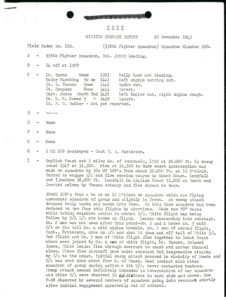
 English Coast out 5 miles No. of Southwold, 1322 at 20,000 ft. In enemy coast 1347 at 31,500. Flew at 31,500 to Hude where interception was made on squadron by 30+ ME 109’s from about 32,000 ft. at 12 o’clock. Turned to engage E/A and flew weaving course to Dutch Coast. Landfall out Ijmuiden 28,000 ft. Landfall in English Coast 31,000 at South End located selves by Thames Estuary and flew direct to base.
English Coast out 5 miles No. of Southwold, 1322 at 20,000 ft. In enemy coast 1347 at 31,500. Flew at 31,500 to Hude where interception was made on squadron by 30+ ME 109’s from about 32,000 ft. at 12 o’clock. Turned to engage E/A and flew weaving course to Dutch Coast. Landfall out Ijmuiden 28,000 ft. Landfall in English Coast 31,000 at South End located selves by Thames Estuary and flew direct to base.
30+ ME 109’S from above at 12 o’clock on squadron which was flying as center of group and slightly in front. At enemy attack dropped belly tanks and broke into them. At this time squadron had been reduced to two four ship flights by abortions. Made two 90 turns while taking evasive action to combat E/A. White flight was being followed by 3 / 4 E/A who broke up flight. Leader descending into overcast. No. 2 man was not seen after this point – No. 3 and 4 broke No. 3 with E/A on his tail No. 4 with engine trouble. No. 1 man of second flight Capt. Patterson, dove on E/A and shot it down and off tail of White 3/. Red flight and No. 3 man of White flight flew together to Dutch Coast where were joined by No. 4 man of white flight, Lt. Turner, Colonel James, White leader flew through overcast to coast and across channel alone. These five aircraft were under constant but inaggressive attacks by E/A to the coast. Initial enemy attack occurred in vicinity of Heede and E/A was shot down about four N. of Emmen. Lost contact with other squadron of group during action with E/A. Never contacted bombers. Enemy attack seemed definitely intended as interception of out squadron and other E/A were observed in distance to each side an above. One P-38 observed by several members of squadron going into overcast shortly after initial engagement apparently out of control.
Some observations…
1) The 338th, comprised of 14 aircraft, departed Nuthampstead at 1259 hours, after the 38th;
2) Like the 38th, the squadron of fourteen planes was depleted by six by the time it was intercepted, thus substantially reducing its strength;
3) Akin to the 38th, the squadron was intercepted by a much larger number of German fighters (in this case, over 30). Again paralleling the 38th’s experience, the enemy planes attacked the squadron – at 31,500 feet – head-on from a slightly higher altitude (32,000 feet);
4) The 338th lost contact with the other “squadron” (squadrons?) of the 55th during combat with German fighters;
5) The squadron was unable to make contact with the B-17s it was assigned to escort;
6) A significant observation: “Enemy attack seemed definitely intended as interception of our squadron and other E/A were observed in distance to each side and above. One P-38 observed by several members of squadron going into overcast shortly after initial engagement apparently out of control.”;
7) Weather conditions ranged from half to nearly complete cloud cover over the English Channel, to complete overcast over the continent.
–
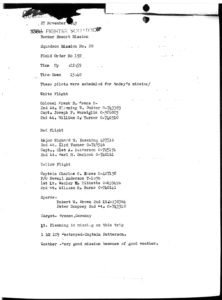
 Transcript of Squadron Formation – 338th Fighter Squadron
Transcript of Squadron Formation – 338th Fighter Squadron
White Flight
James, Frank B., Col. (Group Commanding Officer)
Suiter, Fleming W., 2 Lt.
Marsiglia, Joseph P., Capt.
Turner, William G., 2 Lt.
Red Flight
Busching, Richard W., Major
Turner, Lloyd, 2 Lt.
Patterson, Chet A., 2 Lt.
Garlock, Karl H., 2 Lt.
Yellow Flight
Jones, Charles O., Capt.
Anderson, Newell, F/O
Tibbetts, Wesley M., 1 Lt.
Burns, William H, 2 Lt.
Spares
Brown, Robert W, 2 Lt.
Dempsey, Peter, 2 Lt.

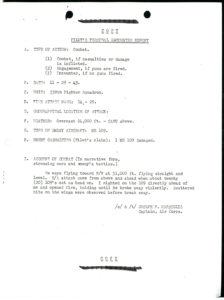 Squadron History – 343rd Fighter Squadron
Squadron History – 343rd Fighter Squadron
Regarding the 343rd Fighter Squadron, information presently available to me – presented below – is limited to the brief account in the squadron’s historical record, rather than an actual Mission Report.
1) This squadron was unable to rendezvous with the 8th Air Force B-17s;
2) The squadron was outnumbered by enemy planes.

Transcript of Squadron History – 343rd Fighter Squadron
On Nov. 29th, Capt. Malmstedt led the Squadron, the mission again being bomber escort to Bremen. R/V was not made with the big ships, but engagement with E/A was pressed as the squadron reached the scheduled point. Superiority of numbers was again in favor of the enemy and while our pilots distinguished themselves, the show was exceedingly rough. During the prolonged engagement, 2nd Lt. James Gilbride was lost to enemy action and none of our pilots observed his disappearance. Beside Capt. Malmstedt, pilots on the mission were: Capts. Franklin, Giller, Ryan, 1st Lts. Hoeper, Barnett, 2nd Lts. Bauer, Birtciel, De Young, Fluty, Gilbride, Stanton, Stephenson and Brown.
The pilot’s names of the 343rd’s fourteen pilots on this mission are listed below, following the sequence of names as listed in the squadron history. This is apparently based on rank, and would almost certainly not represent the organization of the squadron’s four flights. (For example, 2 Lt. James W. Gilbride was wingman to Capt. Rufus C. Franklin, but these mens’ names aren’t adjacent in the list.)
Pilots Participating in Mission – 343rd Fighter Squadron
(Full names Derived from Biographical Profiles at 55th Fighter Group)
Malmstedt, Roland M., Capt. (Led Squadron) (Killed in flying accident in P-38H 42-67076 on 12/2/43)
Franklin, Rufus C., Jr., Capt.
Giller, Edward B., Capt. (To Lt. Col. 4/29/45)
Ryan, Eugene E., Capt. (To Major)
Hoeper, Paul E., 1 Lt. (To Major)
Barnett, John, 1 Lt. (KIA 1/5/44)
Bauer, Harold M., 2 Lt. (To 1 Lt.)
Birtciel, Frank E., 2 Lt. (To Capt. 12/44)
De Young, Arthur A., 2 Lt. (To Capt.)
Fluty, Joseph M., 2 Lt. (To 1 Lt.) (Killed 3/8/44 in P-38J 42-67751)
Gilbride, James W., 2 Lt. (To 1 Lt.) (KIA on this mission … see below)
Stanton, Richard C., 2 Lt. (To Capt.)
Stephenson, Franklin A., 2 Lt. (To Capt.)
Brown, Robert D., 2 Lt. (To Capt.)
And, ten “spares” from the 77th Fighter Squadron of the 20th Fighter Group
The IDPF (Individual Deceased Personnel File) for 2 Lt. Lieutenant Albert A. Albino includes correspondence by Gerrie J. Zwanenburg (of the Royal Netherlands Air Force) from March of 1978, pertaining to the discovery and identification of Lt. Albino’s remains. This communication notes that ten pilots of the 77th Fighter Squadron accompanied the 55th Fighter Group on this mission, “to gain operational experience.” Though the mens’ names are not listed in Zwanenburg’s communication, the identities of two are definitely known, because one of these pilots – John Hascall; see below – was missing that day, and thus his loss was recorded in a MACR.
Frakes, Robert D., 2 Lt., 0-746075
Hascall, John S., 2 Lt., 0-746103
Those Who Did Not Return
20th Fighter Group, 77th Fighter Squadron
2 Lt. John Sherman Hascall, P-38H 42-67016, “LC * O“, MACR 1424
55th Fighter Group, 38th Fighter Squadron
2 Lt. Albert Anthony Albino, P-38H 42-67051, “Spirit of Aberdeen“, MACR 1428
2 Lt. James Michael Garvin, P-38H 42-67046, MACR 1427
Major Milton Joel, P-38H 42-67020, “CG * A“, “flying wolf”, MACR 1429
55th Fighter Group, 343rd Fighter Squadron
2 Lt. James William Gilbride (Bailed out – did not survive), P-38H 42-67097, MACR 1272
Those Who (Eventually) Returned
55th Fighter Group, 38th Fighter Squadron
2 Lt. John Joseph Carroll (Prisoner of War), P-38H 42-67090, “FOB Detroit“, MACR 1431
55th Fighter Group, 338th Fighter Squadron
2 Lt. Fleming William Suiter (Prisoner of War), P-38H 42-67069, MACR 1273
This section presents images from Missing Air Crew Reports for the 20th and 55th Fighter Group pilots lost on this mission. The MACRs are presented by Group and squadron, and then alphabetically by pilot’s surnames.
Detailed information about the fates of Lieutenats Albino, Carroll, Gilbride, Suiter, incomplete information about Lieutenant Garvin, and finally, speculation about what may have happened to Major Joel can be found in the post A Postwar Search: The Missing of November.
Note that the first page of every MACR for a 38th Fighter Squadron pilots bears the signature of Captain Robert W. Wood – at first the squadron’s Communications Officer and later its Executive Officer – from whom more will be heard in the upcoming post Fragments of Memory.
______________________________
2 Lt. John S. Hascall (77th Fighter Squadron, 20th Fighter Group), MACR 1424
(“Spare”, with 2 Lt. Robert D. Frakes)
Here’s a picture of Lieutenant Hascall, from the Michigan Technological University Website.
 Update to this post: As you can see, the above image is actually cropped from this photo, below, found at the Pilot’s Gallery of the 20th Fighter Group website. This photo was evidently taken for publicity or group history purposes, as the Pilot’s Gallery includes an image of at least one other pilot (also garbed in flight suit and helmet; also wearing a Mae West and parachute) posed on the same P-38.
Update to this post: As you can see, the above image is actually cropped from this photo, below, found at the Pilot’s Gallery of the 20th Fighter Group website. This photo was evidently taken for publicity or group history purposes, as the Pilot’s Gallery includes an image of at least one other pilot (also garbed in flight suit and helmet; also wearing a Mae West and parachute) posed on the same P-38.

 Transcript of Certificate – 2 Lt. Robert D. Frakes
Transcript of Certificate – 2 Lt. Robert D. Frakes
On November 29, 1943, I took off for a mission as a spare with Lt. Hascall on my wing, also a spare. We had instructions to join any squadron needing a spare. After many abortions we were the last spare in the group and I fell in on the wing of the second element in the 343rd Squaron. We were about midway over the channel with a solid overcast below at 25,000 feet. I did not see the opening in the 343rd Squadron when Lt. Hascall waved me over. I do not remember whose flight he joined, if any because I did not see any other abortions. My position then was on the front starboard flight and he was flying to the rear port flight. At that time his plane was functioning perfectly.
Transcript of Certificate – 1 Lt. Francis W. Barkley, Intelligence Officer (Detached)
On 29 November 1943 due to the number of planes lost on mission none could be positively identified as Lt. Hascall. However, in compilation of interrogations by Group Intelligence it is though that Lt. Hascall may have gone down in the vicinity East of Aschendorf, Germany where the group was first bounced. Several ships were seen spinning down in this area. No definite knowledge as to identity of these but it is thought that Lt. Hascall got that far along the route as nothing points to his being lost before this.
______________________________
2 Lt. Albert Anthony Albino (38th Fighter Squadron, 55th Fighter Group), MACR 1428
This photo, taken by Sergeant Robert T. Sand, appears in Double Nickel, Double Trouble, and shows 38th Fighter Squadron ground crew members conversing with Lt. Albino (wearing Mae West and sunglasses) in front of his personal P-38 (“Spirit of Aberdeen”) as he describes a just-completed combat mission.
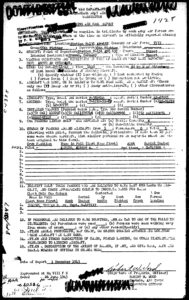 The map below shows what was believed to have been the location where Lieutenants Albino, Carroll, Garvin, and Major Joel were last seen: Over Germany, west of Oldenburg, and specifically west of the intersection of the Leda and Kusten Canals, at the location designated by the blue X. Scanned at the National Archives from MACR 1429, this map is included in the Missing Air Crew Report for each of these four pilots. Note that cartographic reference features primarily comprise canals and rivers, rather than cities.
The map below shows what was believed to have been the location where Lieutenants Albino, Carroll, Garvin, and Major Joel were last seen: Over Germany, west of Oldenburg, and specifically west of the intersection of the Leda and Kusten Canals, at the location designated by the blue X. Scanned at the National Archives from MACR 1429, this map is included in the Missing Air Crew Report for each of these four pilots. Note that cartographic reference features primarily comprise canals and rivers, rather than cities.
 Transcript of Eyewitness Account – Capt. Thomas E. Beaird, Jr.
Transcript of Eyewitness Account – Capt. Thomas E. Beaird, Jr.
Our flight was slightly trailing the other three flights going to the rendezvous. Our flight leader had to fall out and called to me to take over. I acknowledged and called the flight to step up the mercury as I was going to catch up. At this time Lt. Albino was 2nd in the flight, approximately 3 ship lengths behind me and approximately 4 ship lengths in front of Lt. Peters. We were in the same relative position but had closed considerably on the leading flights, when someone called, “Bogies coming down at three o’clock, get rid of your tanks”. I turned to the right dropped my tanks and looked to see if Lt. Albino and Peters had gotten rid of theirs. This was the last time I was able to locate Lt. Peters or Albino as almost immediately we were bounced from approximately 8 o’clock and the lead flights from, I think, about 1 o’clock.
After we tangled there seemed to be nothing but individual ships that joined up to make flights as best they could.
Transcript of Eyewitness Account – 2 Lt. Edward F. Peters
I was flying #2 position in a flight lead by Capt. Hancock. Capt. Hancock started a turn to the right, leaving because of engine trouble, and as we were deep in enemy territory I started with him, however, he called and said I should turn back to accompany group. I started to return but by this time I had fallen way back, out of formation and as I increased manifold pressure my left engine cut out at 24” HG. I continued trying to catch up and ahead of me about ½ a mile was Lt. Albino and ahead of him was Capt. Beaird. He, Lt. Albino, was quite a distance behind Capt. Beaird and I followed for about 4 or 5 minutes. At this time the group was bounced and the order given to drop “babies”. [i.e., “jettison drop tanks”] I looked behind and directly below saw six E/A which I called in. I looked above and behind and saw one E/A diving at me from about 7 O’clock. I broke into him and he fired at me as he passed over top. I looked for the group but as I could only see their contrails, and due to the one faulty engine, I turned and came back alone.
It is possible that the E/A which attacked me or the six below could have continued on their way and caught Lt. Albino as he was straggling.
______________________________
2 Lt. James M. Garvin – Major Joel’s wingman – (38th Fighter Squadron, 55th Fighter Group), MACR 1427
Photo of James Garvin from Double Nickel, Double Trouble
 Transcript of Eyewitness Account – Capt. Rufus C. Franklin
Transcript of Eyewitness Account – Capt. Rufus C. Franklin
On 29 November 1943, my wingman, Lt. J.W. Gilbride, and myself participated in an engagement in which Major Joel, C.O. of the 38th Fighter Squadron, and his wingman, Lt. Garvin, were lost and possibly this statement may shed some light on their disappearance.
The main body of the group was proceeding toward home when Major Joel was heard calling for help from far behind us. Lt. Gilbride and I turned back to help but it took several minutes for us to reach the fight. As we drew near we could see five P-38’s engaged and each had from one to three ME 109’s on its tail. Just before we went into the fight one P-38 rolled over and went down with its left engine leaving a very long and very heavy trail of black smoke and with a 109 directly behind. As my wingman and I flew into the middle of the engagement the E/A were surprised into rolling away from the ships they were attacking and we were all able to take a heading for home. At this time there were four P-38’s left besides my wingman and myself. As we started home we were followed by E/A and we tried to outrun them. One of the four P-38’s ran away from the rest and disappeared. The five of us remaining were eventually caught by the E/A and engaged again.
After we saw the one P-38 go down smoking I did not again recognize Major Joel’s voice on the radio. The five of us that were later engaged by the pursuing E/A were, Capt. Ayers, Capt. Beaird, Lt. Erickson, Lt. Gilbride, and myself. On this attack I lost one engine that had been going bad and when I recovered the only other P-38 visible in the area was piloted by Lt. Erickson. We came out together.
In view of the circumstances it is my personal opinion that the P-83 we saw shot down was piloted by Major Joel and the one that ran away from us was piloted by Lt. Garvin, who did not return.
Transcript of Eyewitness Account – Capt. Jerry H. Ayers
We were on a B-17 escort mission to Bremen, Germany, when at 14:10, just prior to our R.V. point, we were jumped by Hot Bandits.
Major Joel was leading the first section of the squadron composed of eight ships. Lt. Wyche was leading the other Flight in the lead section.
Capt. Hancock was leading the second section and I had the other flight. Due to abortive aircraft Major Joel had lost his second element also Lt. Wyche had lost his. Capt. Hancock and his wingman returned. My second element had returned and we were trying to rejoin into two four ship flights. When we were successively bounced by units from a group of about 40 enemy aircraft from one or two o’clock out of the sun. We turned right into the attack and were engaged for some time. At the time of the first break was the last time that I saw Major Joel and his wingman, Lt. Garvin, that I could recognize them.
______________________________
2 Lt. John J. Carroll (38th Fighter Squadron, 55th Fighter Group), MACR 1431
Portrait of John J. Carroll, from Double Nickel, Double Trouble
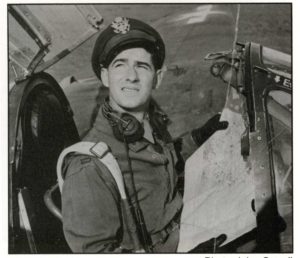 John Carroll’s POW identification photograph, from Double Nickel, Double Trouble. He spent the remainder of the war in Stalag Luft I (North Compound), at Barth, Germany.
John Carroll’s POW identification photograph, from Double Nickel, Double Trouble. He spent the remainder of the war in Stalag Luft I (North Compound), at Barth, Germany.
 Transcript of Eyewitness Account – 1 Lt. Wilton E. Wyche
Transcript of Eyewitness Account – 1 Lt. Wilton E. Wyche
At 14:15 we were attacked by E/A out of the sun at 3 o’clock. Major Joel, leading, with Lieut. Garvin as wingman and my position with Lt. Carroll as my wingman was about 300 yards to the right. A right turn of about 90_ was made and through this I crossed under Major Joel’s element and stopped turning on the left side of the Major’s element.
About six E/A were turning into us from 7 o’clock, and after calling Major Joel to break left, I started a left turn. After turning about 90 (degrees), I tightened my turn too much and my airplane snapped and started to spin. This was the last I saw of Lieut. Carroll or Major Joel and his wingman.
______________________________
Major Milton Joel (38th Fighter Squadron, 55th Fighter Group), MACR 1429
 The eyewitness accounts pertaining to Major Joel’s loss are signed by Captains Jerry H. Ayers and Rufus C. Franklin, Jr., the latter of the 343rd Fighter Squadron.
The eyewitness accounts pertaining to Major Joel’s loss are signed by Captains Jerry H. Ayers and Rufus C. Franklin, Jr., the latter of the 343rd Fighter Squadron.
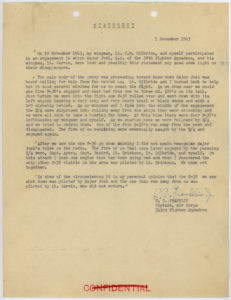 Transcript of Eyewitness Account – Capt. Rufus C. Franklin
Transcript of Eyewitness Account – Capt. Rufus C. Franklin
(Identical to account concerning 2 Lt. James M. Garvin)
____________________
This is the file card bearing Major Joel’s name, from the master name index for Missing Air Crew Reports in National Archives Records Group 92.
Major Joel’s file card is entirely typical of such cards in the MACR master name index, bearing no information other than his name, serial number, and pertinent MACR number. For those men for whom MACRs were never actually filed – and there are cards for many, many such men in the master name index – the data field in the upper right corner is entirely blank or simply says “No MACR”.
____________________
On 29 November 1943, my wingman, Lt. J.W. Gilbride, and myself participated in an engagement in which Major Joel, C.O. of the 38th Fighter Squadron, and his wingman, Lt. Garvin, were lost and possibly this statement may shed some light on their disappearance.
The main body of the group was proceeding toward home when Major Joel was heard calling for help from far behind us. Lt. Gilbride and I turned back to help but it took several minutes for us to reach the fight. As we drew near we could see five P-38’s engaged and each had from one to three ME 109’s on its tail. Just before we went into the fight one P-38 rolled over and went down with its left engine leaving a very long and very heavy trail of black smoke and with a 109 directly behind. As my wingman and I flew into the middle of the engagement the E/A were surprised into rolling away from the ships they were attacking and we were all able to take a heading for home. At this time there were four P-38’s left besides my wingman and myself. As we started home we were followed by E/A and we tried to outrun them. One of the four P-38’s ran away from the rest and disappeared. The five of us remaining were eventually caught by the E/A and engaged again.
After we saw the one P-38 go down smoking I did not again recognize Major Joel’s voice on the radio. The five of us that were later engaged by the pursuing E/A were, Capt. Ayers, Capt. Beaird, Lt. Erickson, Lt. Gilbride, and myself. On this attack I lost one engine that had been going bad and when I recovered the only other P-38 visible in the area was piloted by Lt. Erickson. We came out together.
In view of the circumstances it is my personal opinion that the P-83 we saw shot down was piloted by Major Joel and the one that ran away from us was piloted by Lt. Garvin, who did not return.
 Transcript of Eyewitness Account – Capt. Jerry H. Ayers
Transcript of Eyewitness Account – Capt. Jerry H. Ayers
(Identical to account concerning 2 Lt. James M. Garvin)
We were on a B-17 escort mission to Bremen, Germany, when at 14:10, just prior to our R.V. point we were jumped by Hot Bandits.
Major Joel was leading the first section of the Squadron composed of eight ships. Lt. Wyche was leading the other Flight in the lead section.
Capt. Hancock was leading the second section and I had the other flight. Due to abortive Aircraft Major Joel had lost his second element also Lt. Wyche had lost his. Capt. Hancock and his wing man returned. My second element had returned and we were trying to rejoin into two four ship flights. When we were successively bounced by units from a group of about 40 enemy aircraft from one or two o’clock, out of the sun. We turned right into the attack and were engaged for some time. At the time of the first break was the last time that I saw Major Joel and his wingman, Lt. Garvin, that I could recognize them.
_____________________________
2 Lt. James W. Gilbride (338th Fighter Squadron, 55th Fighter Group), MACR 1272
Photo of James Gilbride from Double Nickel, Double Trouble

 Transcript of Eyewitness Account – Capt. Rufus C. Franklin
Transcript of Eyewitness Account – Capt. Rufus C. Franklin
On the mission of November 29, 1943, target – Bremen, I was leading Whiteman Yellow Flight composed of Lieutenants James W. Gilbride, Harold Bauer and an unidentified spare, flying numbers 2, 3 and 4 respectively.
At approximately 1210 hours, I reported many bandits approaching from below at 3 o’clock; this was about in the target area. Colonel James had started a right turn to meet the enemy aircraft when we met about 16 enemy aircraft head-on at about 29 to 30,000 feet. The main body of the Group went into a right Lufberry Circle for approximately two complete turns. Colonel James was [not] leading the Group at or from this time, as he was having engine trouble and was below us. My second element disappeared about this time as Lieutenant Bauer was having trouble losing his belly tanks. Lieutenant Gilbride stayed with me in an excellent manner, calling in enemy aircraft calmly and doing a good job of covering. The main Group stayed in their Lufberry but I would break out momentarily from time to time to get my wing out of the sun so that I could see if another attack was imminent.
About this time, after two complete turns, the main Group started home and I, thinking that the Group Commander had resumed the lead, followed along. As we left the area there were several people calling for help from far behind. The main Group continued on away until we were at least seven miles from this fight.
Just as I had almost decided to go back and help the boys calling repeatedly, the Group started a turn and appeared to be going back but instead made a tight 360 degree turn and went away from the fight again. I could see the fight behind us as the Group made the turn and I broke out – Lt. Gilbride and I went back to help.
As we drew near we saw one P-38 go down smoking very heavily and probably on fire. We could see 4 other P-38s in a dog-fight in a small area, each with 1 to 3 ME 109s on his tail. Lt. Gilbride and I drove right into the middle of the fight and the enemy aircraft were so surprised that they pulled away from the ships they were chasing and began to climb again. The 4 P-38s we had helped started for home while Lt. Gilbride and I were making a 180 degree turn to try to go with them. One P-38 ran away from us, 2 were well in front and 1 was straggling. Five ME 109s out to one side and about a mile back were chasing us. The straggling P-38 was caught by Gilbride and I and we joined line abreast about 175 yards apart. The straggler was Lt. Erickson of the 38th Fighter Squadron.
At this point my left turbo went bad and the engine began to lose all of its oil. We tried to outrun the pursuing 109s but the other 2 38s weren’t fast enough and mine was only putting out 30 inches manifold pressure on the left engine. The enemy aircraft closed down slowly to about 800 yards behind, 700 yards to the side and 1000 feet above. Suddenly one of 109s slid away from his flight and with his superior altitude closed down to 400 yards behind me, I was middle ship of the three. Lt. Gilbride started to break back into him but I told him to sit tight as that was just what the Jerries wanted. The enemy aircraft sat within range for about a minute, not firing, and then moved over on Gilbride’s tail. I edged over toward Gilbride and the enemy aircraft changed back to my tail. The enemy aircraft made the change 4 times. I was determined not to fall for their bait and forced myself and the other two to continue straight ahead.
Finally the other 4 enemy aircraft moved up abreast of Lt. Erickson, on my left, and started into us. I called “break”, and the three of us turned into them. At this point my left engine quit, I feathered, continued my break about 100 degrees and then turned back toward home. Lt. Gilbride was behind as my engine quit but when I regained control and looked he was not there. I continued and 1 P-38 appeared behind me with 4 109s behind him. They were all closing me very rapidly, so I unfeathered the left engine, intending to use it until it caught fire. The P-38 pulled along side, pilot Erickson, and the enemy aircraft were approximately 500 yards back.
Erickson and I stayed abreast for about 2 minutes with the enemy aircraft following. I took a look around the area and when I looked back the enemy aircraft were no longer following. I eased off the left engine and Erickson and I came home. The enemy aircraft had followed us just past the Dutch coast.
Lt. Gilbride disappeared at approximately 1240 hours about 12 miles east of Keppel. The one ME 109 that had been trying to bait us had half rolled when the three of us broke into the four and it is possible that Gilbride followed him and got into trouble. The other four followed the two of us so it is impossible to say how many Lt. Gilbride became engaged with later, if such be the case. Neither Erickson nor I heard Gilbride say anything over the radio about trouble and we had maintained good radio contact until that time.
We later identified three of the four P-38 pilots who had helped us as Captain Ayers, Captain Beaird and Lieutenant Erickson, all of the 38th Fighter Squadron. The fourth man’s name has not been ascertained, nor has the name of the man who was shot down.
______________________________
2 Lt. Fleming W. Suiter (343rd Fighter Squadron, 55th Fighter Group), MACR 1273

 Transcript of Eyewitness Account – Capt. Chet A. Patterson
Transcript of Eyewitness Account – Capt. Chet A. Patterson
I was flying lead position in second flight at the time we were approximately 10 miles north of Emmen, Holland, when we met 4 head on attack of 30 plus Enemy Aircraft. I turned right to engage the enemy, and then saw four friendly aircraft behind and below, being attacked. The friendly aircraft which I identified as flown by 2nd Lt. Fleming W. Suiter, 0-713363, appeared to be shot down as he went down through the overcast. This was the last I saw of Lt. Suiter.

